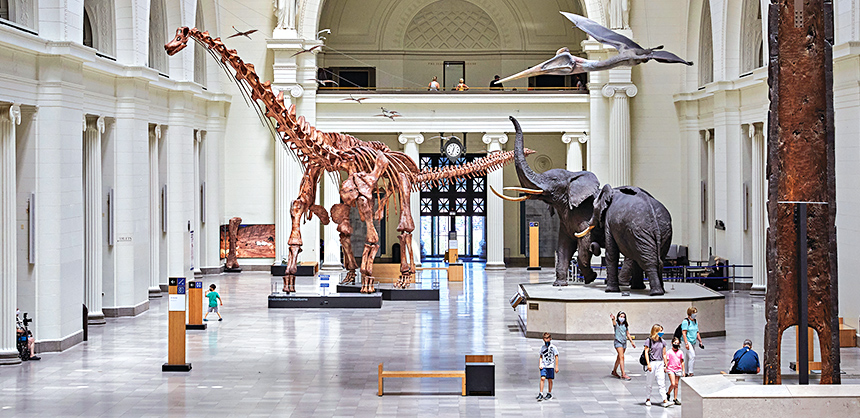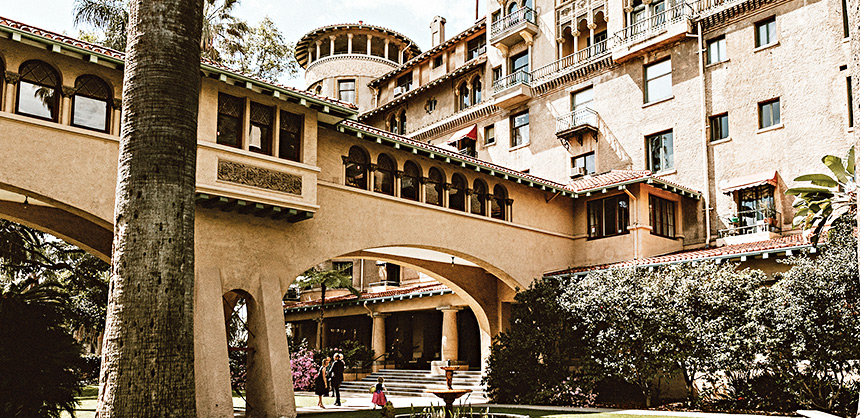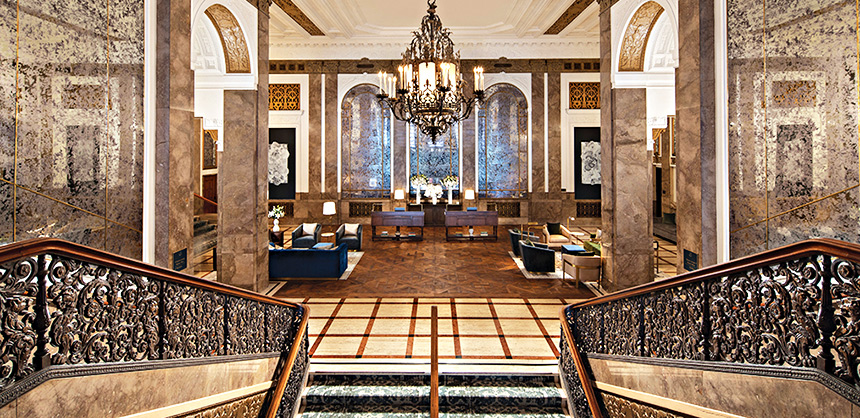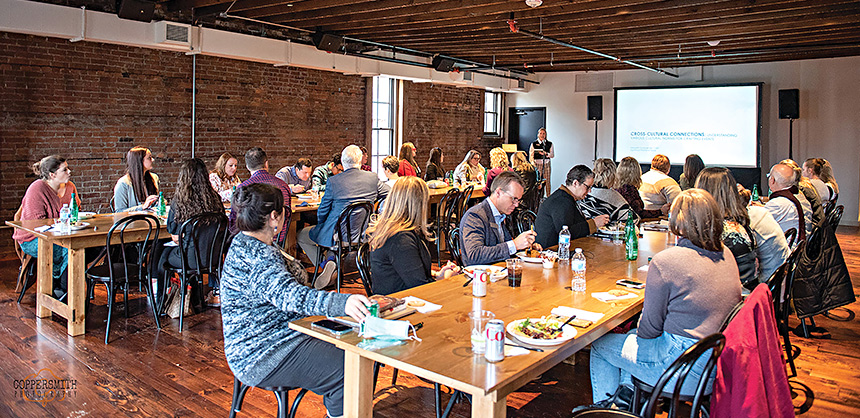Historic RendezvousAugust 9, 2023
Venues with Charm & Character By Maura KellerHistoric Rendezvous
Venues with Charm & Character
With nearly half a million sf overall, the Field Museum in Chicago, Illinois, can fit your meeting needs. Courtesy Photo
Glistening chandeliers, stunning architectural elements, exposed brick walls and awe-inspiring murals are just some of the facets of historic venues that both corporate event planners and attendees are drawn to.
For Andria Marcus, membership engagement manager and events planner at California Independent School Business Officers Association (Cal-ISBOA), historic venues are excellent options for meetings and events given their unique ambiance, cultural and historical value, and memorable setting.
“The distinctive charm, architectural details and cultural significance of these venues create an atmosphere that leaves a lasting impression on attendees,” Marcus said. “Hosting an event at a historic venue allows participants to immerse themselves in the rich history and heritage associated with the location, adding a sense of prestige and cultural significance.”
The unique surroundings of a historic venue also serve as conversation starters and icebreakers among attendees, fostering networking and creating a more engaging environment. With versatile spaces and iconic photo opportunities, historic venues provide a memorable and impactful backdrop for a wide range of meetings and events.
For Kastina Morrison, event planner and owner of Kastina & Co., historic venues give something special to an event, such as extra character and ambiance you could not have created on your own.
Attendees always seem to be intrigued by the story and history they are walking into, according to Morrison, who said, “It keeps that history alive and supports a structure that may have been torn down if not saved, preserved and used today.”
One of Morrison’s favorite historic places to host corporate events was ARIA in Minneapolis. Before it sold last year, is was one of the best historic venues in the nation. As Morrison explains, ARIA was the country’s first “self-storage facility” with four stories. The large part of the warehouse eventually became a theater in the 1980s; the theater had catwalks for lighting and balcony seating created by blowing out three levels and creating a big open space.
“There’s been nothing like it since,” Morrison said. “To be able to hang floral installations and rig lighting from a fourth-story catwalk inside an old warehouse was magic. Our clients would select this venue because of the historic charm, the uniqueness of the space, the exposed brick, the cool old gears left, and the stories to them. Unlike some historic buildings, you couldn’t damage this space since it was made out of concrete and brick.”
Marcus went on to say that planners gravitate toward historic venues because they offer a unique and captivating setting that can elevate the overall experience for attendees.
“The charm, character and architectural details of these venues create an atmosphere that is distinct from traditional spaces, making the event more memorable and special,” Marcus said. “Historic venues often have cultural and historical significance, providing an opportunity to immerse participants in the heritage and story of the location.”
As Marcus pointrf out, this adds a layer of distinction and interest to the event, making it more engaging and enriching. Hosting an event at a historic venue can enhance event promotion, attendee participation and social media visibility.
“The blend of charm, cultural value and memorable ambiance makes historic venues an enticing choice for planners looking to create a truly remarkable event experience,” Marcus said.

Castle Green, a nationally registered historical monument in Los Angeles, has a 6,400 sf ballroom and an outdoor garden that seats 500. Photo by Gina & Ryan Photography
Recently, Cal-ISBOA hosted its annual conference and meeting at Beacon Grand in San Francisco. As a state organization, Cal-ISBOA strives to accommodate members located throughout California, hosting the annual conference in one of the main hubs, and when possible, San Francisco or Los Angeles.
“This year, we had record-breaking attendance, in part because of the beautiful location we selected and the accessibility of the area for so many of our members,” Marcus said. Their event usually begins, he said, “with a board meeting, followed by the pre-conference human resources workshop, the celebratory kick-off dinner, and ends with the annual conference and meeting.”
After visiting other modern venues, it was clear to Marcus that conference attendees prefer participating in a unique experience.
“Many of our members attend conferences on a regular basis, so providing them with a memorable experience was paramount,” Marcus said. “Several of the board members shared fond memories of visiting San Francisco as children and staying at this very hotel.”
For Christy Gandy, vice president of operations, Florida Ports Council, hosting an event at a historical location with rich history means that the event doesn’t just have a venue, but the venue itself creates an experience for attendees.
“This gives me, as the planner, the opportunity to create an environment that boosts the excitement of my attendees before, during, and after the event,” Gandy said.
The Florida Ports Council hosts its annual board of directors’ meeting every year in a port city. They had not hosted a meeting in Key West, Florida, since 2004 and decided it was time to go back.
“I selected the Casa Marina because of its historical charm,” Gandy said. “I knew this venue would encourage inspiration as it provides an environment where people can listen and engage with both the discussion subjects and the history of the location,” Gandy said.
Listed in the National Register for Historic Places, Casa Marina is a century-old historic landmark exuding Key West elegance and in proximity to the vibrant Duval Street and rich history of Old Town.
“When considering a historic venue as the location for your event, remember, although it may be embedded with history and the past, it doesn’t mean that it isn’t modern and technologically functional,” Gandy said. “Most historic venues have features that can enhance and celebrate the historic nature of the locaion.”
Debbie Schroder, director of meetings and events at Copart, also believes historical venues leave a lasting impression on the attendees.
“It’s always fun to hear stories of the past and see the places where they unfolded,” Shroder said.
She held a customer advisory board meeting at historic Casa Marina where they hosted key customers and their spouses. They chose the venue because it’s iconic in Key West and has such historical significance. Other factors included its location on the water and being within walking distance of so many popular spots in Key West.
Casa Marina, which is currently undergoing renovations, has more than 11,000 sf of indoor meeting space, plus plenty of outdoor terraces and beach options. They plan to reopen in the fall.

The Beacon Grand is a San Francisco luxury hotel that boasts 17,000 sf of event space in downtown Union Square. Courtesy Photo
Plenty of Options
The U.S. is teeming with historic venues for corporate and incentive travel events. From centuries-old hotels to historic museums, to legendary landmarks, there are simply a wealth of historic venues from which to choose.
In New Orleans, the Hotel Monteleone has been family-owned and operated since 1886. Located in the historic French Quarter, this hotel is an official literary landmark, inspiring some of the country’s best authors, making it an excellent option for small and mid-sized events. It has more than 26,000 sf of meeting space available.
In Pasadena, California, Castle Green is one of the oldest historic landmarks in the Los Angeles area, offering a rich history and impressive architecture with modern amenities. A Nationally Registered Historic Monument, Castle Green was built in 1898. It operates today as a luxurious venue with a 6,400 sf ballroom that can seat up to 200 attendees and an outdoor garden that can accommodate 500 attendees.
A Midwest favorite, The Field Museum in Chicago, established in 1893, is a historic natural history museum sure to impress attendees and accommodate events big and small. Events can be held indoors or outdoors in their terraces, field hall, atrium, theater and elsewhere. The museum provides an attractive backdrop for any event, from their incredible exhibits to their view of the Chicago skyline and Lake Michigan. They have more than 32,000 sf of meeting and event space available.
What better way to celebrate the South than hosting an event in a renovated mill in the heart of Greensboro, North Carolina. Opened in 1898, Revolution Mill was originally the first flannel mill in the South. After it closed in 1984, it sat vacant for the next two decades. Today, it has been completely renovated and offers numerous meeting and event spaces, as well as outdoor performance areas, apartments, offices and a small museum celebrating the historical significance of the mill.
Since 1928, St. Pete Beach, Florida, has been home to The Don CeSar, the iconic “Pink Palace” that is a member of the National Trust’s Historic Hotels of America. This historic beachfront resort has undergone a full-property renovation, completed last spring, and offers more than 38,000 sf of meeting and event space, including terraces, verandas, and outdoor garden spaces.

The Gatherings at Station 10, a historic firehouse in St Paul, Minnesota, offers a perfect venue for small groups with 5,000 sf of event space. Photo by Coppersmith Photography
It’s In the Details
When hosting an event at a historic venue Marcus recommends meeting and event planners need to make sure the staff is on their side. In addition, it is crucial to thoroughly understand the limitations and capabilities of the venue.
“Historic venues often have specific restrictions and guidelines due to their age and preservation needs,” he said. “Being aware of these factors, such as sound limitations or decoration rules, is essential for successful event planning.”
Additionally, it is important to assess the logistics by conducting a site visit. Understanding the layout, available spaces and potential challenges will help in designing the event flow and making necessary arrangements. It is equally important to consider attendees’ needs, ensuring the venue has suitable facilities and addresses factors like accessibility and transportation. Having a contingency plan is crucial to handle unforeseen circumstances and ensure a smooth event execution.
Again, with the venue’s team behind them, planners can leverage the unique charm and historical value of the venue to create a memorable and successful event,” Marcus said.
Morrison added that hosting an event at a historic venue comes with its fair share of challenges. The biggest issues can be the structures heating and cooling systems and whether or not it’s ADA compliant.
“If you think about it, really all the utilities of a historic building can be an issue in keeping up with what we expect now to be available,” Morrison said. “Power can be hard; whether that’s not enough power for the caterer’s equipment or the band pulls too much. Old mansions don’t have the big ballrooms we typically need these days for an event of 150 attendees and more.”
Considering ADA-compliant issues, there often isn’t an elevator in historic spaces. If there an elevator, it’s a very tiny one with not enough room for attendees or servers with large trays of food to get up. Ramps that help a space be wheelchair accessible aren’t built-in like they are today. And hosting events at historic homes can be the trickiest considering ADA accessibility, as they don’t necessarily have to be up to current commercial code as private residences.
That’s why Morrison recommends planners who are considering historic venues check the utilities and understand the accessibility needs of the attendees. Planners should consider the following questions:
- Does the historic venue have the power you need for your event, especially for catering and entertainment vendors?
- Does it have heating and cooling that will be sufficient in keeping the attendees comfortable?
- Can those on the attendee list access the building?
- Do you have anyone in a wheelchair that would need accommodations?
Challenges aside, Jessica Barrett, founder at Bigger Picture Solutions, an event venue consulting firm, agrees that historic venues can add an element of interest and surprise to your event just simply from the storytelling aspect.
“Attendees love to hear about what a building was used for in the past, who owned it or how it’s changed over the years, Barrett said. “It gives them something interesting to talk about amongst each other and to take back with them as a part of the overall experience.”
However, Barrett added, the important things to think of when hosting at a historic venue might be a few more limitations than you’d find at a newer building. As she explains, the load in for vendors can be more challenging, doorways may not be as generous, and they may be more valuable with what can be done from a decor perspective in order to preserve the space.
“In historic spaces, there are often elements that simply cannot be replaced and are a huge part of the appeal, but keeping them fresh requires some additional vigilance or rules,” Barrett said. “Ask for the venue’s assistance in creating any floor plans to make sure whatever you are dreaming of can be accomplished in real life, and always double check measurements to make sure they are all correct to scale and will fit.” This includes making sure elements, from AV equipment to F&B ware, will fit through doorways and staircases if necessary.
Also, make sure to ask about power; not just that there’s an outlet to plug into but how many are on each circuit.
“Blowing a fuse mid event is never fun,” Barrett said. “Ask the venue operators about interesting details of the space beforehand to see if there are ways you can incorporate that into the event’s overall theme or branding.” C&IT








